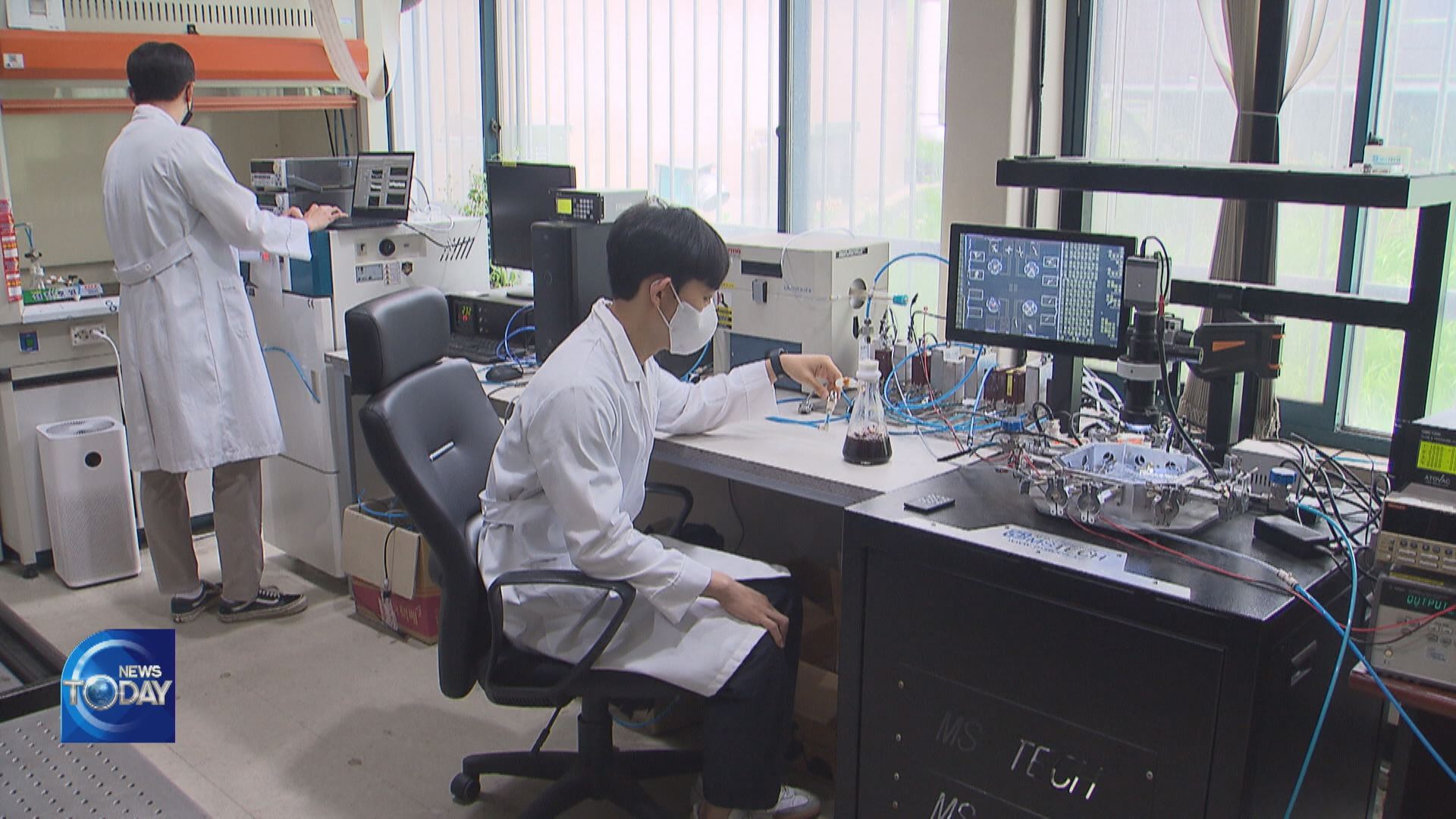ARTIFICIAL ELECTRONIC NOSE
입력 2022.07.05 (15:04)
수정 2022.07.05 (16:46)
읽어주기 기능은 크롬기반의
브라우저에서만 사용하실 수 있습니다.
[Anchor Lead]
Researchers from the Korea Advanced Institute of Science and Technology have developed an artificial electronic nose modeled after human olfactory nerve cells. Using a semiconductor sensor, the artificial nose can detect the smell and discern wines like a sommelier. It can also detect harmful gases.
[Pkg]
Of the 12 pairs of human cranial nerves, the very first one is olfactory nerves. The sensory cells inside the nose transmit electrical signals called spikes to the brain for smell detection. This is how sommeliers can discern wines not only by color and taste, but also by smell using their olfactory sense. This neuromorphic module, or "electronic nose," was developed by researchers from KAIST. It was modeled after human olfactory nerve cells. When wine in a tube is inserted in the module, a semiconductor sensor detects various gas molecules and switches chemical signals to electrical ones, just like human olfactory nerves. Using analyzed data, this artificial nose can discern the type of wine, the year it was produced and the degree of its fermentation.
[Soundbite] Han Jun-kyu(KAIST Electrical Engineering) : "This device can detect gas substances with small amounts of electricity using semiconductor metal oxide-based gas sensors and single transistor neurons to produce electrical spike signals."
The artificial nose can also detect harmful gases like carbon monoxide and ammonia. It can be used to prevent gas leaks and food spoilage, as well as for health care purposes.
[Soundbite] Prof. Choi Yang-kyu(KAIST Electrical Engineering) : "With the advent of the IoT era, compact sensors are in high demand. This device is expected to be used in diverse AI research projects."
In addition to the neuro-morphic semiconductor module modeled after the human brain and the senses of sight and touch, the researchers also plan to develop an AI nerve cell module with all five human senses, including smell, taste and hearing.
Researchers from the Korea Advanced Institute of Science and Technology have developed an artificial electronic nose modeled after human olfactory nerve cells. Using a semiconductor sensor, the artificial nose can detect the smell and discern wines like a sommelier. It can also detect harmful gases.
[Pkg]
Of the 12 pairs of human cranial nerves, the very first one is olfactory nerves. The sensory cells inside the nose transmit electrical signals called spikes to the brain for smell detection. This is how sommeliers can discern wines not only by color and taste, but also by smell using their olfactory sense. This neuromorphic module, or "electronic nose," was developed by researchers from KAIST. It was modeled after human olfactory nerve cells. When wine in a tube is inserted in the module, a semiconductor sensor detects various gas molecules and switches chemical signals to electrical ones, just like human olfactory nerves. Using analyzed data, this artificial nose can discern the type of wine, the year it was produced and the degree of its fermentation.
[Soundbite] Han Jun-kyu(KAIST Electrical Engineering) : "This device can detect gas substances with small amounts of electricity using semiconductor metal oxide-based gas sensors and single transistor neurons to produce electrical spike signals."
The artificial nose can also detect harmful gases like carbon monoxide and ammonia. It can be used to prevent gas leaks and food spoilage, as well as for health care purposes.
[Soundbite] Prof. Choi Yang-kyu(KAIST Electrical Engineering) : "With the advent of the IoT era, compact sensors are in high demand. This device is expected to be used in diverse AI research projects."
In addition to the neuro-morphic semiconductor module modeled after the human brain and the senses of sight and touch, the researchers also plan to develop an AI nerve cell module with all five human senses, including smell, taste and hearing.
■ 제보하기
▷ 카카오톡 : 'KBS제보' 검색, 채널 추가
▷ 전화 : 02-781-1234, 4444
▷ 이메일 : kbs1234@kbs.co.kr
▷ 유튜브, 네이버, 카카오에서도 KBS뉴스를 구독해주세요!
- ARTIFICIAL ELECTRONIC NOSE
-
- 입력 2022-07-05 15:04:39
- 수정2022-07-05 16:46:01

[Anchor Lead]
Researchers from the Korea Advanced Institute of Science and Technology have developed an artificial electronic nose modeled after human olfactory nerve cells. Using a semiconductor sensor, the artificial nose can detect the smell and discern wines like a sommelier. It can also detect harmful gases.
[Pkg]
Of the 12 pairs of human cranial nerves, the very first one is olfactory nerves. The sensory cells inside the nose transmit electrical signals called spikes to the brain for smell detection. This is how sommeliers can discern wines not only by color and taste, but also by smell using their olfactory sense. This neuromorphic module, or "electronic nose," was developed by researchers from KAIST. It was modeled after human olfactory nerve cells. When wine in a tube is inserted in the module, a semiconductor sensor detects various gas molecules and switches chemical signals to electrical ones, just like human olfactory nerves. Using analyzed data, this artificial nose can discern the type of wine, the year it was produced and the degree of its fermentation.
[Soundbite] Han Jun-kyu(KAIST Electrical Engineering) : "This device can detect gas substances with small amounts of electricity using semiconductor metal oxide-based gas sensors and single transistor neurons to produce electrical spike signals."
The artificial nose can also detect harmful gases like carbon monoxide and ammonia. It can be used to prevent gas leaks and food spoilage, as well as for health care purposes.
[Soundbite] Prof. Choi Yang-kyu(KAIST Electrical Engineering) : "With the advent of the IoT era, compact sensors are in high demand. This device is expected to be used in diverse AI research projects."
In addition to the neuro-morphic semiconductor module modeled after the human brain and the senses of sight and touch, the researchers also plan to develop an AI nerve cell module with all five human senses, including smell, taste and hearing.
Researchers from the Korea Advanced Institute of Science and Technology have developed an artificial electronic nose modeled after human olfactory nerve cells. Using a semiconductor sensor, the artificial nose can detect the smell and discern wines like a sommelier. It can also detect harmful gases.
[Pkg]
Of the 12 pairs of human cranial nerves, the very first one is olfactory nerves. The sensory cells inside the nose transmit electrical signals called spikes to the brain for smell detection. This is how sommeliers can discern wines not only by color and taste, but also by smell using their olfactory sense. This neuromorphic module, or "electronic nose," was developed by researchers from KAIST. It was modeled after human olfactory nerve cells. When wine in a tube is inserted in the module, a semiconductor sensor detects various gas molecules and switches chemical signals to electrical ones, just like human olfactory nerves. Using analyzed data, this artificial nose can discern the type of wine, the year it was produced and the degree of its fermentation.
[Soundbite] Han Jun-kyu(KAIST Electrical Engineering) : "This device can detect gas substances with small amounts of electricity using semiconductor metal oxide-based gas sensors and single transistor neurons to produce electrical spike signals."
The artificial nose can also detect harmful gases like carbon monoxide and ammonia. It can be used to prevent gas leaks and food spoilage, as well as for health care purposes.
[Soundbite] Prof. Choi Yang-kyu(KAIST Electrical Engineering) : "With the advent of the IoT era, compact sensors are in high demand. This device is expected to be used in diverse AI research projects."
In addition to the neuro-morphic semiconductor module modeled after the human brain and the senses of sight and touch, the researchers also plan to develop an AI nerve cell module with all five human senses, including smell, taste and hearing.
이 기사가 좋으셨다면
-
좋아요
0
-
응원해요
0
-
후속 원해요
0

















이 기사에 대한 의견을 남겨주세요.